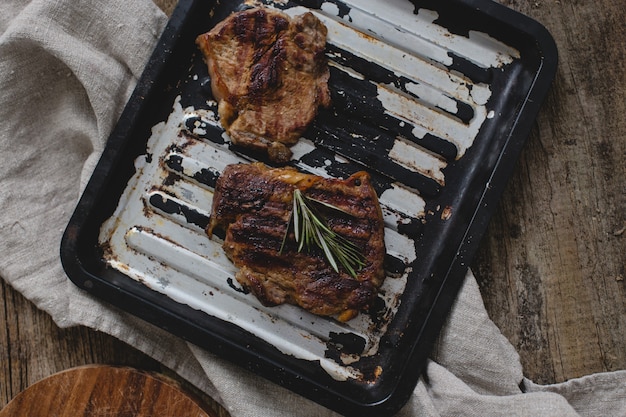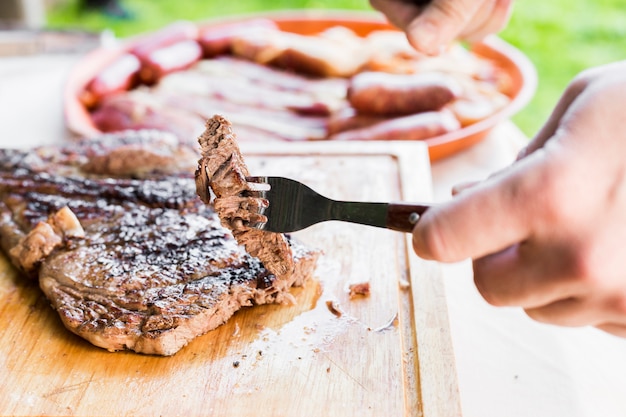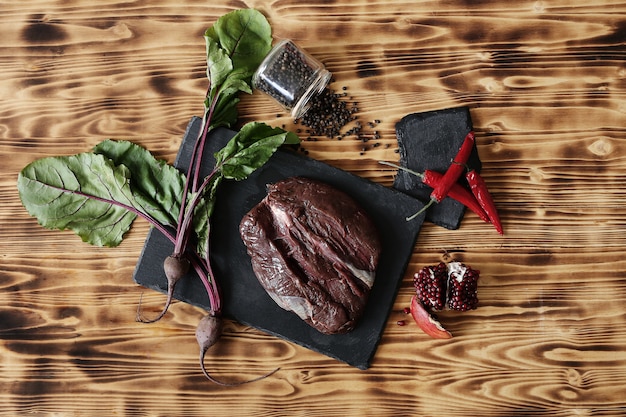prime rib. The mere mention of those two words conjures images of decadent dinners, crackling fires, and a table brimming with laughter and good company. It's a dish that screams "celebration" and "I'm a bloody good cook," and honestly, it's not as intimidating as you might think. I've been cooking prime rib for years, and I've learned a thing or two along the way. So, grab your apron, put on your favourite playlist, and let's dive into this prime rib masterclass. We're going to cover everything from selecting the perfect cut to achieving that succulent, melt-in-your-mouth texture. By the end of this, you'll be a prime rib pro, trust me.
(Part 1) Selecting the Prime Rib: The Foundation of a Great Roast

Let's start at the beginning, the most important step: choosing the right cut of beef. Now, you want to be looking for a "prime rib roast" or a "standing rib roast." It should be a bone-in cut, with at least three ribs, and preferably more. A 5lb roast is a good size for feeding a decent crowd, but if you're feeding a small army, you might want to go bigger. I've got a tip: always ask your butcher for advice, they're absolute wizards when it comes to meat. They can help you select a roast with the right amount of marbling, which is key for achieving that juicy and flavorful result.
The Importance of Marbling: Understanding the White Streaks
Speaking of marbling, that's the white fat streaks that you see throughout the meat, and it's what makes prime rib so delicious. It melts down during cooking, baste the meat and adds a ton of flavour. It's like nature's built-in butter! The more marbling, the richer and more succulent your roast will be.
A Quick Guide to Marbling Grades: Choosing the Right Level of Richness
You'll see different grades of marbling, like "Select," "Choice," and "Prime." "Prime" is the highest grade, meaning it has the most marbling and is generally the most flavorful. It's like the superstar of the meat world. "Choice" is a great option too, and it’s often more affordable. Think of it as the dependable, all-around player. If you're on a budget, "Select" can be a decent choice, just don't expect it to be as rich and juicy as "Prime" or "Choice." Think of it as the budget-friendly option, still good but not quite as indulgent.
Beyond Marbling: Other Factors to Consider
Beyond the marbling, there are a few other things to check before you buy:
- Look for a roast with a good amount of fat around the outside. This fat layer helps to keep the meat moist and flavorful. Imagine it as a natural barrier, protecting the juicy meat inside. And remember, we can always trim some fat off before cooking.
- Make sure the meat is firm and springy to the touch. You don't want a roast that feels mushy or soft, as this could be a sign that it's not fresh. Think of a good bounce to your roast, like a well-inflated bouncy castle.
- If you can, smell the meat. It should have a fresh, meaty aroma. Imagine that delicious smell of a roast cooking in the oven. If you smell anything off or funky, give it a miss.
(Part 2) Preparing the Prime Rib: Setting the Stage for Success

Alright, you've got your prime rib, now it's time to get prepped.
1. Trim the Fat (But Not Too Much!)
Remove the majority of the fat from the outside of the roast, leaving a thin layer behind. The fat will baste the meat during cooking, keeping it moist and adding flavour. Remember, it's better to have a little too much fat than not enough, because you can always trim off more if needed. Think of it like a protective blanket for the meat, keeping it warm and juicy.
2. Seasoning: The Key to a Flavourful Symphony
Now for the fun part: seasoning. Here's where you can really get creative. I love to use a simple blend of salt, pepper, and garlic powder, but you can add herbs like rosemary, thyme, or oregano for a more complex flavour. For a real kick, consider adding a bit of chili powder. I like to season the roast generously, making sure to get the fat layer as well. This way, the flavours infuse the roast as it cooks, creating a symphony of deliciousness.
3. The Secret Weapon: A Dry Brine for Ultimate Tenderness and Flavor
Here's a game-changer: a dry brine. This is essentially a layer of salt that draws moisture out of the meat, then redistributes it, making it incredibly juicy and flavorful. It's super easy: Simply rub the roast with a generous amount of salt, making sure to cover all sides. Wrap the roast tightly in plastic wrap and refrigerate for at least 4 hours, or even overnight. This is the time to put on a podcast, catch up on your favourite TV show, or just relax with a cuppa. The salt does the magic, and you get to enjoy some downtime!
(Part 3) Cooking the Prime Rib: The Big Event

Now comes the moment we've all been waiting for – cooking that prime rib to perfection. I'm a big fan of roasting in the oven, but you can also grill it if you prefer. I'll talk you through my preferred oven method, but don't worry, we'll cover grilling too.
1. Preheat the Oven: Setting the Stage for a perfect sear
Get your oven nice and hot, to about 450°F (232°C). This gives the meat a lovely sear on the outside, sealing in those juices. Think of it as giving the prime rib a warm welcome, getting it ready for the main event.
2. Roasting the Prime Rib: The Time to Let the Magic Happen
Place the seasoned roast in a roasting pan. Add a bit of water to the bottom of the pan to create some steam, which will help to keep the meat moist. Think of it as a little cloud of moisture, keeping the prime rib happy and hydrated.
3. Time for a Temperature Check: Ensuring Perfection with Precision
Now, here's the crucial part: you want to cook the prime rib to an internal temperature of 135°F (57°C) for medium-rare, 145°F (63°C) for medium, and 160°F (71°C) for medium-well. Use a meat thermometer to check the temperature in the thickest part of the roast, avoiding bone. Think of the meat thermometer as your trusty sidekick, ensuring the roast is cooked to your exact preference.
4. Resting is Key: Allowing the Juices to Redistribute
Once it's reached your desired temperature, take the roast out of the oven and let it rest for at least 15 minutes. This allows the juices to redistribute throughout the meat, ensuring a tender and juicy result. Cover the roast loosely with foil to keep it warm while it rests. Think of this as a well-deserved break for the roast, a chance to calm down and release its full potential.
5. The Final Touches: Carving and Serving the Star of the Show
After resting, slice the roast against the grain, creating beautiful, even slices. Serve it with your favorite sides, like roasted vegetables, mashed potatoes, or Yorkshire pudding. The prime rib is ready to shine, ready to be the star of your delicious meal.
(Part 4) Grilling the Prime Rib: A Delicious Alternative for Summer Feasts
If you're feeling adventurous and want to grill your prime rib, here's what you need to know.
1. Prepare the Grill: Setting the Stage for a Smoky and Delicious Roast
Heat your grill to medium-high heat, and make sure it's nice and clean. You want to achieve a good sear without any flare-ups. Think of your grill as a mini-oven, ready to give the prime rib a smoky kiss.
2. Cooking the Prime Rib: Grilling for a Smoky, Delicious Flavour
Place the roast on the grill and cook for about 15 minutes per side, rotating the roast every few minutes to ensure even cooking. Think of it like a dance, gently rotating the roast to give each side its fair share of grilling time.
3. The Resting Stage: Letting the Juices Reabsorb for Maximum Tenderness
After grilling, transfer the roast to a cutting board and let it rest for at least 15 minutes, covered loosely with foil. This allows the juices to redistribute, making for a truly succulent prime rib. Think of it as a chance for the roast to catch its breath, and for those delicious juices to settle back in.
4. Carving and Serving: Presenting Your Masterpiece
Once the roast has rested, carve it against the grain, and serve with your favourite sides. The smoky flavour of the grilled prime rib will be a real treat.
(Part 5) The Art of Carving Prime Rib: Making Your Roast Look as Good as it Tastes
Carving a prime rib can seem daunting, but it's actually quite simple.
1. The Right Tools: Choosing Your Carving Companions
You'll need a sharp carving knife and a carving fork. A carving knife is long and thin, designed to slice through meat cleanly, while the carving fork is used to hold the roast in place. Think of them as the perfect team for a professional carving job.
2. Carving Technique: Slicing with Precision and Care
Place the roast on a cutting board. Using the carving fork to hold the roast in place, start slicing the roast against the grain. The grain runs in the direction of the muscle fibers, so slicing against the grain will make the meat more tender. Imagine slicing through a rope, going against the direction of the strands to make it easy to break.
3. Even Slices: Creating a Visually Appealing Presentation
Aim for slices that are about 1/2 inch thick. If the roast is bone-in, you can slice the meat around the bone, then carve the bone out once the roast is sliced. Think of it like a jigsaw puzzle, carefully working around the bone.
(Part 6) prime rib leftovers: A Delicious Second Chance
You've cooked the perfect prime rib, and now you're left with some leftovers. Fear not, leftovers are amazing!
1. Storage: Keeping Your Prime Rib Fresh for Later
Refrigerate the leftover prime rib in an airtight container for up to 3 days.
2. Reheating: Bringing Your Leftover Roast Back to Life
There are a few ways to reheat prime rib. You can reheat it in the oven at 350°F (175°C) for about 20 minutes, or you can slice it up and reheat it in a skillet with a bit of butter or oil. You can also use a microwave, but be careful not to overcook it. Think of the leftovers as a blank canvas, ready for a delicious second act.
3. Delicious leftover recipes: Transforming Leftovers into New Dishes
Prime rib leftovers can be used in all sorts of delicious dishes. Here are a few ideas:
- Prime Rib Sandwiches: Slice the leftover prime rib and pile it high on toasted bread. Add a dollop of horseradish sauce for a spicy kick.
- Prime Rib Soup: Shred the leftover prime rib and add it to a hearty soup. Combine it with vegetables, broth, and a sprinkle of herbs for a comforting meal.
- Prime Rib Salad: Slice the leftover prime rib and add it to a salad for a delicious protein boost. Pair it with a vinaigrette, fresh greens, and crunchy vegetables for a delightful combination.
(Part 7) Pairing Prime Rib with the Perfect Wine: Completing the Culinary Symphony
No prime rib feast is complete without a good bottle of wine.
1. Red Wine Recommendations: Choosing the Perfect Wine for Your Roast
For a prime rib, you'll want to choose a red wine with bold flavours that can stand up to the richness of the meat. Here are some of my favourites:
- Cabernet Sauvignon: A classic pairing with prime rib, Cabernet Sauvignon has rich fruit flavours and a full body that pairs perfectly. Think of it as a robust partner for the rich roast.
- Merlot: Another great choice, Merlot has a softer, more approachable profile with notes of plum and chocolate. Think of it as a smooth and elegant compliment to the roast.
- Zinfandel: This bold red has intense fruit flavours and a spicy finish. Think of it as a bold and daring choice, adding a touch of excitement to the meal.
2. White Wine Alternatives: Exploring Beyond the Traditional
While red wine is the traditional pairing, if you prefer white, don't be afraid to try a full-bodied white like a Chardonnay or Viognier. Their rich flavors and notes of oak will compliment the roast well. Think of it as a sophisticated twist on the classic pairing, a delightful surprise for the palate.
(Part 8) FAQs: Your Prime Rib Questions Answered
Q: How long should I cook a 5lb prime rib?
The cooking time for a 5lb prime rib will vary depending on the desired level of doneness. Here's a general guideline:
| Doneness | Internal Temperature (°F) | Cooking Time (approx.) |
|---|---|---|
| Rare | 125°F | 15-20 minutes per pound |
| Medium-Rare | 135°F | 20-25 minutes per pound |
| Medium | 145°F | 25-30 minutes per pound |
| Medium-Well | 160°F | 30-35 minutes per pound |
| Well-Done | 170°F | 35-40 minutes per pound |
Remember, these are just estimates. It's always best to use a meat thermometer to ensure the roast is cooked to your desired level of doneness. Think of the thermometer as your personal chef, ensuring the roast is cooked to perfection.
Q: Can I cook a prime rib from frozen?
Technically, you can cook a prime rib from frozen, but it will take longer to cook and may not be as tender and juicy. It's best to thaw the roast in the refrigerator for at least 24 hours before cooking. Think of it as giving the roast a chance to relax and come back to life before cooking.
Q: What are some good sides to serve with prime rib?
Prime rib is a classic dish that pairs well with a variety of sides. Here are a few of my favourites:
- Roasted Vegetables: Roasted potatoes, asparagus, Brussels sprouts, and carrots all make a great accompaniment to prime rib. Think of them as colourful and flavourful companions for the roast.
- Mashed Potatoes: A creamy and comforting side that's perfect for soaking up the juices of the prime rib. Think of them as a warm hug on a cold day, comforting and delicious.
- Yorkshire Pudding: A traditional British side that's light and airy and goes wonderfully with prime rib. Think of it as a light and fluffy counterpoint to the rich roast.
- Creamed Spinach: A rich and creamy side that contrasts beautifully with the rich flavour of the prime rib. Think of it as a creamy and delicious foil for the roast, adding a touch of elegance to the meal.
- Gravy: A must-have for any prime rib dinner. You can make a simple gravy from the pan drippings or go for something more elaborate. Think of it as the finishing touch, bringing all the flavours together.
Q: How do I make a great gravy from the pan drippings?
Making gravy from the pan drippings is a simple and delicious way to enhance your prime rib dinner. Here's what you need to do:
- Remove the roast from the pan and set it aside.
- Pour off any excess fat from the pan.
- Add a tablespoon of flour to the pan and whisk it around to coat the bottom of the pan.
- Gradually add broth or water to the pan, whisking constantly until the gravy thickens.
- Season the gravy with salt and pepper to taste.
Q: How can I make sure my prime rib is cooked evenly?
To ensure your prime rib is cooked evenly, use a meat thermometer to check the internal temperature in the thickest part of the roast. Make sure the thermometer isn't touching bone, as this will give an inaccurate reading. It's also helpful to rotate the roast halfway through cooking, to ensure all sides are cooked evenly. Think of it like a little dance, gently rotating the roast to ensure a beautiful golden brown colour and a perfectly cooked centre.
Everyone is watching

How to Cook Frozen Lobster Tails Perfectly: A Step-by-Step Guide
RecipesLobster. Just the word conjures up images of lavish meals, special occasions, and a taste of luxury. But let's...

Pigs in a Blanket Cooking Time: How Long to Bake for Perfect Results
RecipesAh, pigs in a blanket. Just the name conjures up images of those delightful little parcels of crispy pastry en...

Pork Fillet Cooking Time: How Long to Cook It Perfectly
RecipesPork fillet, or tenderloin as it's sometimes called, is a real favourite in our house. It's so versatile, and...

The Ultimate Guide to Cooking Delicious Frankfurters
RecipesLet's face it, we all love a good frankfurter. It's a classic, simple, and always satisfying. But let's be rea...

Wolf Meat Recipes: A Guide to Cooking Wild Game
RecipesLet's be honest, you don't see wolf meat at your local butcher shop every day. It's a bit of a wild card, but ...
